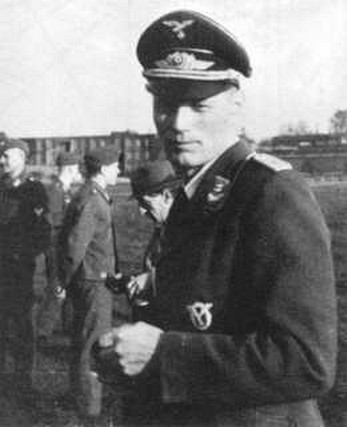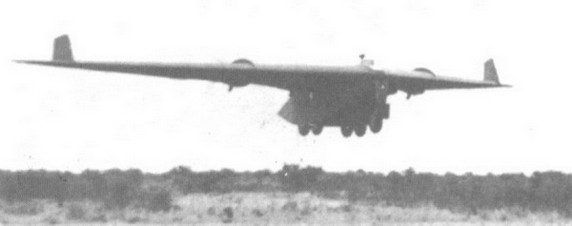Reimar Horten In Argentina

Reimar Horten
Reimar Horten was born in Bonn, Germany on March 12, 1915. He entered into Aeronautics thanks to his brother, who was 28 months older than he was, who built the Ho I when he was 16 years old. It was a one-manned glider without a fuselage, made out of wood and a coated fabric.  The experience gained in building the Ho I made it possible to build the Ho II in 1934, and by the following year, it was motorized with an 80 HP Hirt HM 602. In 1938, both of the brothers worked together to construct the Ho III, whose internal body was made up of steel pipes welded together and its external with the traditional structure made of wood coated with fabric. At the beginning of 1939, two famous constructors, Ernest Heinkel and Willy Messerschmitt, wanted to merge their companies with the Horten's, but the Horten brothers realized that, by accepting this, they would loose their freedom to develop their winged fliers, and for this reason, the rejected both offers.
The experience gained in building the Ho I made it possible to build the Ho II in 1934, and by the following year, it was motorized with an 80 HP Hirt HM 602. In 1938, both of the brothers worked together to construct the Ho III, whose internal body was made up of steel pipes welded together and its external with the traditional structure made of wood coated with fabric. At the beginning of 1939, two famous constructors, Ernest Heinkel and Willy Messerschmitt, wanted to merge their companies with the Horten's, but the Horten brothers realized that, by accepting this, they would loose their freedom to develop their winged fliers, and for this reason, the rejected both offers.
The Second World War had already started when the German Ministry of Aviation (RLM), working with the Special 9, which was established in Gotingen, gave the Horten brothers the opportunity that they were waiting for and allowed them to build the Ho IV.
The Ho IV was a glider without a fuselage or a motor. It had an elongation of 22 to 1 and it had peculiar design in that the pilot's entire body was introduced into the plane's frame lying down. In 1943, with highs and lows in the production of the Ho VII that was equipped with two 240 HP Argus AS 10 C motors, Walter and Reimar -without official authorization- decided to start a new project, the Ho IX, which was a flying wing with a jet-engine. In this unpublished experience, they only had BMW and JUMO motors at their disposition. The development of the 20 pre-production models -with advice from the Horten brothers- was officially authorized by the RLM to the Gothaer Wagonfabrik company, where they titled it the GO-229. Responding to an official job offer, the Horten brothers came to our country in 1948, but two years later, Walter decided to go back to Germany.
Meanwhile, Reimar dedicated himself to the construction of two different glider models (the IA-34 "the Clen Antu" and the IA-41 "Urubu"), a transport (the IA-38), and a jet fighter, all of them being flying wings. On October 19, 1949, the Brig. Juan Ignacio San Martín, who was in charge of the FMA (Fabrication of Military Aviation), presented the secret file 339 with Horten's project to the Brigadier Cesar Ojeda, the Minister of Aeronautics. The project consisted of a jet fighter with a double delta wing, two drifts on the wings, and internal fuel tanks (four in the wings and one in the cabin). The air intake of the Rolls Royce Derwent V turbine with which the plane was going to be equipped was placed in a ventral form and its internal guns were four 20 mm cannons. Horten planned on reaching higher maximum velocities, lower landing velocities, and have a higher ceiling service than the Pulqui II (the fighter plane with which Kurt Tank was working). Finally, on April 4, 1951, the project was archived, because the Pulqui II's development was farther ahead and because Argentina could not afford to build two jet-planes at the same time.
Nevertheless, Horten continued working in Argentina, this time on the IA-37, which is also a flying wing, but very different from all of the earlier models. In 1953, he started to do his tests in a wind tunnel, and, under the supervision of Karl Nickel, he made over 200 take offs of models between 5 and 20 kg to test its aerodynamics. Doing this, he reached up to 200 km per hour. In 1954, he built a wooden glider that was presented to the public in March and that flew for the first time on October 1st, which was towed by a Junkers Ju-52. It was later towed by the DC-3 and the Lincoln LV-ZEI (Lincolian, Aries II). Its pilot was the Captain Conan Doyle. It was also a model in which the pilot flew lying down. First Lieutenants Balado, Rossell, and Gonzalez, as well as the German pilot Heinz Scheidhauer participated in the following flight tests.
The flight characteristics were excellent, above all, the take offs and landings were very smooth. It needed very little runway because of its nose that was tilted upward, and because of this, it had a higher front axle. In the models with a motor, they foresaw that the front axle would lift up at a 5 to 25 degree angle during take off and that it would do the opposite during the landing, which would allow the glider to use a shorter runway.
In 1955, Horten started to build a prototype that would use a Derwent V motor, which wasn't going to allow it to reach the required performance, but it would serve to test different systems. The problem with the motor was that Horten couldn't get a higher-powered motor in a foreign country, and Argentina wasn't equipped with the proper equipment to be able to build it. A little later, he was able to upgrade it. In 1956, he changed the position of the pilot from lying down position to a sitting one, and after having recorded 50 hours of flight time with the glider, he started to build the first prototype. In the design, they foresaw the need of a Derwent V motor or two Avon's, and they believed that it could become a plane with more power, leaving the IA-37 behind as a subsonic trainer. This model, called the IA-48, would be equipped with two Rolls Royce Avon R.A.3 with 2,950 kg of push, two Nene 101 with 2,267 kg of push, or 2 Bristol Orpheus BOr with 2,200 kg of push under the wings, which would have a delta ogival or gothic shape. The plane was believed to be able to reach Mach 2.2.
The Armed Forces were interested in the model, believing that it could be used in their new aircraft carrier that had arrived in 1958, and for this reason, the plane suffered several changes, how the exhaust fumes left the motors. In 1960, when they only needed one more year before they could put the IA-37 into flight, the project was cancelled for lack of funding. This is how Argentina lost out on being able to create their own fighter jet, something that wouldn't come to take place until 1984, when the IA-63 Pampa flew for the first time.
IA-38 Orangeman  The Engineer Reimar Horten presented the prototype of what was a tetra-motor flying wing transport. Its construction was begun in 1953. The design was based on the German project of what was the II GM Horten Ho VIII. The prototype was finished in 1959, but the first test flight was delayed because there was a problem in the motors cooling system. Finally, the first flight took place on December 10, 1960, under the command of Major Rogelio Manuel Balado. Towards the end of 1961, the prototype -the only one ever built, - after flying only four times, was abandoned due to unsatisfactory results. The engine was made up of 4- I Ae 16 "el Gaucho". It had 9 radial cylinders that put out 450 HP at 2,250 RPM and that turned the propellers, which had a fixed pitch. Originally, they wanted to use a different motor, the IA R-19 R "El Indio", which put out more HP. The fuel capacity was 1,450 liters, and it was transported in the wings. It was a high-wing monoplane, semi-monocoque, bilarguera structure that was built
The Engineer Reimar Horten presented the prototype of what was a tetra-motor flying wing transport. Its construction was begun in 1953. The design was based on the German project of what was the II GM Horten Ho VIII. The prototype was finished in 1959, but the first test flight was delayed because there was a problem in the motors cooling system. Finally, the first flight took place on December 10, 1960, under the command of Major Rogelio Manuel Balado. Towards the end of 1961, the prototype -the only one ever built, - after flying only four times, was abandoned due to unsatisfactory results. The engine was made up of 4- I Ae 16 "el Gaucho". It had 9 radial cylinders that put out 450 HP at 2,250 RPM and that turned the propellers, which had a fixed pitch. Originally, they wanted to use a different motor, the IA R-19 R "El Indio", which put out more HP. The fuel capacity was 1,450 liters, and it was transported in the wings. It was a high-wing monoplane, semi-monocoque, bilarguera structure that was built  entirely of duralumin, in an arrow-like form of 36.5 º. It didn't have a tail unit, and the drifts and rudders were located in the tips of the wings. The landing axle had four principal, fixed wheels and one front wheel that could be retracted into the fuselage. The cockpit, with two seats in tandem, was situated on the edge of the wing. The cargo hold, which was very large, had a capacity of 23 m3, and could transport six tons of cargo. For this reason, it was incorporated with a wide "crocodile mouth" rear door. The bottom part of the "crocodile mouth" was, at the time, used as a ramp when open.
entirely of duralumin, in an arrow-like form of 36.5 º. It didn't have a tail unit, and the drifts and rudders were located in the tips of the wings. The landing axle had four principal, fixed wheels and one front wheel that could be retracted into the fuselage. The cockpit, with two seats in tandem, was situated on the edge of the wing. The cargo hold, which was very large, had a capacity of 23 m3, and could transport six tons of cargo. For this reason, it was incorporated with a wide "crocodile mouth" rear door. The bottom part of the "crocodile mouth" was, at the time, used as a ramp when open.
characteristics
Wingspan: 32 m
Length: 13.50 m
Height: 4.60 m
Wing Area: 133 m2
Gauge: 2.80 m
Weight when empty: 8,500 kg
Useful Cargo: 7,500 Kg
Total Weight: 16,000 kg
Wing Cargo: 120 Kg/m2
Ratio between weight and power: 17.77 kg/HP
Maximum Speed: 252 km/h
Cruising Speed: 215 Km/h
Landing Speed: 140 km/h
Range: 1,250 kilometers
The Dr. and Engineer Reimar Horten died on August 21, 1993, in Villa General Belgrano (Cordoba, Argentina).

